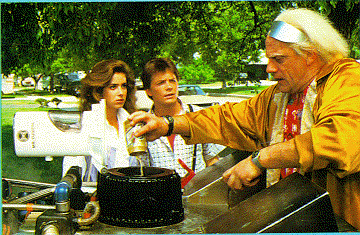
It solves all the problems, especially of having to seperate stuff out to recycle.
Posted on 09/28/2007 9:27:36 AM PDT by SirLinksalot
Detroit – With gas prices over $3 a gallon and violence roiling the Middle East, the political drumbeat for oil alternatives has never been louder. President Bush has vowed to “change how we power our automobiles,” and a newly elected Democratic Congress is demanding drastic increases in auto fuel efficiency aimed at achieving “oil independence.” Quick to reflect the public mood, auto companies are touting gas substitutes and predicting the twilight of the gas engine.
But I wouldn’t bet on the twilight of the gas engine just yet.
At this year’s Society of Automotive Engineer’s convention in Detroit, one forum debated the question: “The Gasoline Engine Is Dead. Or Is It?” Siemens executive Michael Crane answered matter-of-factly: “For the foreseeable future, the gasoline engine will continue to dominate.” At present, Crane pointed out, gas powers 90-percent of autos on the planet with its fossil-fuel cousin, diesel, feeding most of the remainder. Only in Brazil and South Africa, where governments have dictated national alternative energy programs, has that supremacy been challenged.
Gasoline’s 100-year reign is no fluke: It offers high energy density per pound (125,000 BTU/gallon) at low production cost, with a manageable supply infrastructure. And gas engine technology is ever-advancing.
Today’s gas engines are near zero-emission vehicles. “If I mow my lawn for one hour,” says Crane, “I’d produce more emissions than if I drove a new car from New York to Los Angeles.” So clean is Ford’s Durotech engine, for example, that it meets California’s zero-emissions standard along with the celebrated Toyota Prius hybrid.
Still, auto insiders anticipate domestic politics and continued high gas prices will force major vehicle fleet changes. Don Whitsett, of auto supplier Aisin Corp., predicts a “greater mix of fuel technologies.” But what might those technologies be?
Hybrid gas/electrics. Automakers estimate that increasing mpg targets by 40 percent, as the U.S. Senate wants, may increase costs by $5,000 per vehicle. That cost calculation is based on building more hybrid vehicles, which combine a gas engine and electric motor and have shown some promise in the U.S. market, with the advertisement of 40-percent fuel economy gains.
“Because of their two-drive system, hybrids are relatively expensive,” says Whitsett, adding that hybrid fuel economy hasn’t lived up to the hype. The EPA concedes that its mileage estimates for hybrids have been exaggerated by 25-percent. For example, under revised figures for the 2008 model year, the Prius mpg rating will drop from 56 mpg into the mid-40s. This means hybrid fuel economy will be on par with new – and much cheaper - “clean” diesel technologies on their way to the U.S.
Clean diesel. Diesels are why Aisin’s Whitsett says “hybrids are not the ultimate answer.” Using turbocharged direct-injection technology, modern diesels are significantly cleaner – and faster – than soot-belching diesels of yore. And because clean diesels are both cheaper than hybrids and 30-percent more efficient than their gas-powered peers, Whitsett believes that diesel’s U.S. moment has arrived.
Indeed, in Europe – where gas costs $7 a gallon - diesel power has captured over 50-percent of the new car market (though – attention U.S. senators - automakers are well shy of a decade-old government goal of 25-percent fuel mileage reduction).
Still, hybrid and diesel are oil products. To attain true “oil independence,” alternative energy advocates say, transportation must run on biofuels made from crops. In the U.S, that means corn-based ethanol.
Ethanol. Thanks to a loophole in fuel economy regulations that grants credits for ethanol-capable vehicles, many new U.S. models are “flex-fuel” vehicles, meaning they can run on gasoline or E85 ethanol (gas mixed with 85-percent ethanol). But at just 84,600 BTU/gallon, a gallon of ethanol goes only two-thirds as far as a gallon of gas. Ethanol also absorbs water, handicapping development of ethanol fuel’s infrastructure because it cannot be shipped by pipeline.
Sugar-based ethanol. While biofuel faces hurdles in the U.S., it boasts a 40-percent market share in Brazil thanks to state-imposed mandates, an equatorial climate, and huge sugarcane production (30-percent of world production).
Unlike the U.S., where corn must be fermented into sugar ethanol (a hugely energy intensive process that, by some estimates, consumes more fossil fuel to make than a gallon of ethanol saves), Brazilian E100 ethanol is inherently more cost-effective because it comes directly from sugar cane.
Furthermore, according to a 2005 World Bank study, Brazil subsidizes sugar ethanol by $1.20 per gallon (the U.S. corn ethanol subsidy is 51 cents), and mandates that all gas contain at least 20-percent ethanol (the U.S. mandates 5-percent). In order to make up for ethanol’s 30-percent per gallon energy deficiency, Brazil taxes a gallon of ethanol 30-percent less than gas and bans the use of diesel-powered cars.
Liquified coal. In the 1970s, coal-rich South Africa – under pressure from international anti-apartheid sanctions – made a significant state investment in coal-to-liquid gas technology. Today, the method feeds 38-percent of that nation’s transportation fuel demand.
The process has received considerable interest from the U.S. coal industry, given America’s status as the “Saudi Arabia of coal.” However, liquefied coal is expensive (a refinery costs twice that of a traditional gas refinery), and, despite their oil independence rhetoric, America’s greens and their political allies have snubbed the technology because coal is dismissed as a “dirty” energy source.
Electric cars. General Motors has been headlining international auto shows this year with the introduction of its Chevy Volt concept – a so-called “plug-in hybrid” that differs from gas/electric hybrids because only the electric motor drives the wheels (the small gas engine charges the generator). This means the Volt can travel 40 miles on electricity alone, while gas hybrids switch to the gas engine over 25 mph. But bringing the Volt to market by GM’s 2010 goal will require huge strides in lithium ion batteries, which currently catch fire or explode when the battery is under duress. Such drawbacks, obviously, are unacceptable in vehicle transportation
Ultimately, GM is designing the Volt platform to take a hydrogen fuel cell, the fuel many see as the long-term fuel solution. For now, however, hydrogen’s infrastructure costs keep its potential out of reach
At the dawn of the twentieth century, gasoline bested steam and battery power as the central source of power in transportation. Now, a century later, transportation power faces fresh challengers. But, short of massive government edicts, oil will likely remain king.
— Henry Payne is a writer and editorial cartoonist for the Detroit News.
I saw one back in the '70's in Galveston TX demonstrated by a couple of NASA engineers. They pulled a loaded tandem dump truck with a 4 cyl Volvo down Seawall Blvd. In general, the mpg doubles with this method. They also had a Ford Grenada in Popular Science Magazine a little later that went from 16mpg with gas to over 30 mpg with the hydraulic hybrid. My aunt worked for the Galveston Daily News and followed up about a year or two later and found that someone bought the company the Nasa guys started. Not a peep after that. "Google" hydraulic hybrid and you will see Ford has one and many freight carriers are using them like UPS or Fedex. They are good for heavy vehicles because the power from hydraulic pressure is very powerful to start a truck or bus moving. You can get up to 20-30mph( depending on the size of the accumulator), before the engine kicks up off of idle. Then the engine runs at peak power to re charge the accumulator and then cuts back to idle.
I think one of the main problems is it is old tech and there isn't much you could patent as pressurized hydraulic motors have been used for 100 years. There's no money involved so it would just be to save the planet and no profit motive. I guess Ford will work on it for 20 years and Toyota will come out with one and make a few hundred billion.
Think about the high cost of scooping up the poop.
Maybe algore can collect of carbon emmisions!
Bullfrog
Good points all. I see Hydrogen as the high end replacement for gasoline. It can be made from water, using electricity. One scenario would be self-contained wind-to-hydrogen convresion ‘farms’, where the Hydrogen is picked up by tank trucks.
This neatly addresses two of winds current problems: it tends to be producing electricity at times of low demand (night) and it tends to be located far from where the juice is needed, or often even where transmission is available.
It’s not a panacea, but it has potential to be the best alternative fuel in terms of performance and convenience. Historically these critera win out in the market.

It solves all the problems, especially of having to seperate stuff out to recycle.
Our gasoline engines have improved greatly since the sixties. Most of this improvement has been in reducing pollution and increasing power output, but engines have also become more efficient during this time.
However, gasoline engines still supply less than 1/3 of the energy, obtained by burning gasoline, to the output shaft. This is primarily due to two factors, thermal inefficiency (much of the energy is discarded as waste heat), and mechanical inefficiency (the linkages that transfer energy from piston movement to a rotating shaft, are not optimal).
In the last few years, breakthroughs have been made in both of these areas. There is still a lot of development that must take place before these can make a lot of difference, but I expect that both will be greatly improved.
The mechanical (bottom end) breakthrough is already in limited production. The thermal breakthrough needs a lot more work before it can become practical.
An air burning vehicle. Hot air expansion with low spark ignition.
Actually, there is no need to carry around tanks of gaseous hydrogen. It can be made from water on demand inside the vehicle.
Not from electricity in a battery, but from the electrical potential in metalic aluminum. Aluminum oxidation will free hyrdrogen gas from water. The oxidation normally stops as soon as a coating of aluminum oxide forms. Gallium in the water will attract the aluminum oxide and prevent it from forming a coating, allowing the metalic aluminum to oxidize completely, using the electricity that went into forming it to free hydrogen from the water.
So you start with a tank full of metallic aluminum, gallium and water end up with hydrogen gas, aluminum oxide and gallium. The gallium is just a catalyst and does not bond to the aluminum oxide. The aluminum oxide is sent back for your windmills to turn back into metallic aluminum, and new pure metalic aluminum granules are added to the tank.
Details at http://www.physorg.com/news98556080.html
That’s where you and I differ.
I’ve cranked the numbers all the way through the hydrogen “fuel” system, and it is a huge loss compared to just about any other alternative we’d care to discuss.
The central problem is that hydrogen is hard to contain. If we had such an idea as what you pointed to with aluminum, then that would work, but hydrogen is incredibly “fluffy” (ie, non-dense) as a energy storage medium, and very prone to transfer losses in liquid or gaseous phases.
It is an excellent idea, and it clearly works.
The one problem in a consumer vehicle is the obsession Detroit has for taking the cheapest possible route out of all problems. As a farmer, I have to deal with hydraulic systems on darn near all equipment. Without constant attention to the seals and lines, hydraulic systems leak. Not fast leaks, not show-stopping leaks, but these itty-bitty little leaks that leave a sheen of hydraulic oil near the leak.
Which then starts attracting and retaining dust.
They’re infuriating, but pretty much an accepted part of dealing with a hydraulic system.
Still, hybrid and diesel are oil products.
Herr Diesel’s original engine ran on linseed oil.
Diesels can burn any vegetable oil
diesel fuel contains 138000 BTU per gallon
Too many ‘emissions’ LOLOL...
God put it there for us to use, and until a truly viable technology becomes available [ and ignorantly burning FOOD is not one} AND cost effective, oil will rule for transportation.
A nuke plant and refinery per state and drill our own oil, along with coal technologies coming online and gas prices would fall and opec could pound sand...
Nitroglycerin
Since the oxidizer is in the mixture there is no need for air intakes or exhausts pipes. I am thinking if the Nitric acid is combined with the glycerin in the combustion chamber the danger of uncontrolled explosion is much less.
Nitric acid is produced from the air and glycerin is an animal product so that it is renewable.
Heavy fuel oil(heating oil) is higher. I don’t know for sure, but I would bet that tar and rubber are higher yet. Crude probably is too. But the problems with these thick, black, goopy fuels is that they have very low volatility and flashpoints. It’s hard to make them burn reliably and cleanly.
where can I get a can of compressed hydrogen for the trip to the lake???
“Come on ice cream”...

***
Here is the article about that station, in Washington D.C. The article is from 2004, so it's been there for a while.
*****
WASHINGTON - About four miles east of the U.S. Capitol, in an industrial section of town, sits a gas station that looks like any other. But it’s not, because on Wednesday it became the first in North America to have a hydrogen dispensing pump.
Shell executives, Energy Secretary Spencer Abraham and District of Columbia Mayor Anthony Williams unveiled the technology, which the Bush administration hopes will help reduce the country’s dependence on foreign oil.
*****
Japan has 12 stations, in case you're driving your Hydrogen RX-8 in the land of the rising sun.

**** Meanwhile on the Left Coast, California is testing Hydrogen pumps and has them up and runnnig. 
 ***Fill 'er up, Bud?
***Fill 'er up, Bud?
 Ford Concept Vehicle.
Ford Concept Vehicle.
Meanwhile Ford has delivered working ICE vans to a few places, including Canada.
ICE Shuttle Buses to Canadian Senate 14 December 2006
Ford Delivers 3 Hydrogen shuttles for the (Canadian) Senate.
Ford of Canada recently became the first automaker to deliver hydrogen-fueled vehicles for fleet use in Canada. Three Canadian-made hydrogen-fueled internal combustion engine-powered shuttle buses are replacing gasoline-powered buses used by the Senate of Canada in Ottawa.
In addition, Ford of Canada is preparing seven more hydrogen shuttle buses for use in other regions of Canada. Ford announced the development of its H2ICE Shuttle Bus—based on an E-450 chassis cab and powered by a modified 6.8-liter V-10 Triton engine—in 2004. Eight H2ICE E-450 shuttles are going into service in Florida. (Earlier post.)
Industry Canada has invested C$4.2 million (US$3.6 million) toward the hydrogen internal combustion engine Shuttle Bus Demonstration Project. The government’s contribution under Industry Canada’s Hydrogen Early Adopters (h2EA) program is part of an C$8.5-million project being undertaken by Ford of Canada in partnership with ATFCAN, a not-for-profit group, to demonstrate the operation of hydrogen-powered shuttle buses in real-world conditions.
The tech may come along eventually, but I'll stick with gas & diesel for a long time to come...
Disclaimer: Opinions posted on Free Republic are those of the individual posters and do not necessarily represent the opinion of Free Republic or its management. All materials posted herein are protected by copyright law and the exemption for fair use of copyrighted works.